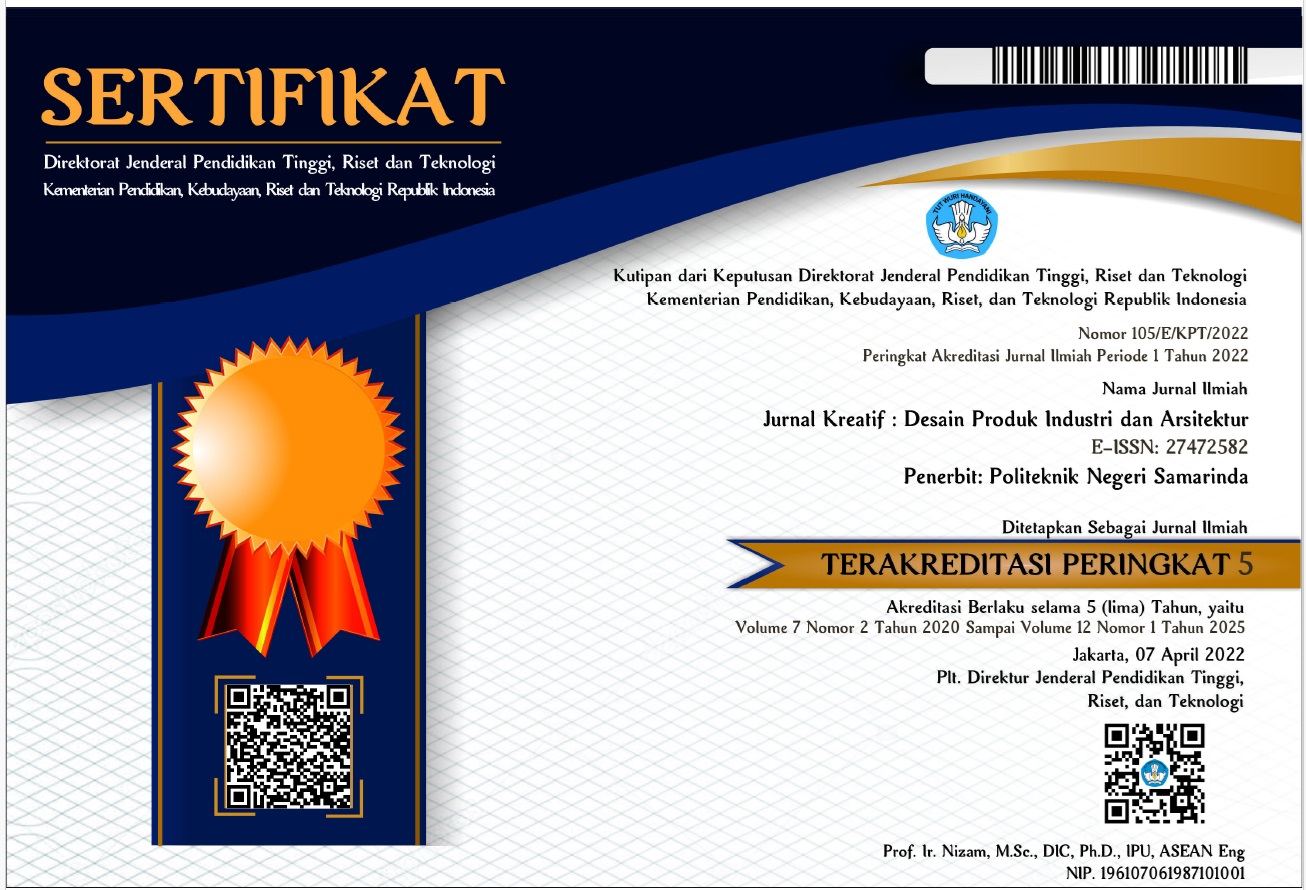DESIGNING FOR ERGONOMIC GAWANGAN BY USING A ROLLER
 Abstract views: 167
,
Abstract views: 167
,
 PDF downloads: 141
PDF downloads: 141
Abstract
Batik craftsmen needed a tool to help them while writing on the carving fabric (covering the motif on the fabric) with wax. They use gawangan for buffering the writing fabric for the sake of the easiest way for the writing process and the fabric is not folded. This is because if the fabric is pleated, the wax on the fabric will harden, break off, and come off the fabric. For this long time, the craftsmen still used the wooden gawangan, and only wrote a unit of batik once a time in the production process. The main problem is how to make the fabric after the wax process saving safely. Gawangan that using roller is a kind of innovation that has never been made before, in Jambi, moreover in Indonesia or maybe in the world. The dimension of the design will use anthropometric data so that the gawangan is ergonomic. The main purpose of this design is to ensure that the fabric that has been long waxed is safe, without any anxiety about the motif on the fabric breaking due to broken wax. Further, this gawangan is designed to accommodate rolls of fabric up to 100 meters.
Downloads
References
Dewi, D. C., Handayani, C., & Novrianti. (2019). Design of ergonomic grated coconut squeezer. Paper presented at the Material Science and Engineering. .
Dewi, D. C., Handayani, C., & Prasetyo, I. (2019). Perancangan Alat Spinner Ergonomis (Study Kasus PT. Baasithu, Floating Storage and Offloading Petrostar). Jurnal Inovator 2(1).
Firmansyah, R., & Bahalwan, H. (2021). Desain Interior Bus Tingkat Sleeper Class. Vol.9, No.2, Oktober 2021, . Jurnal Kreatif : Desain Produk Industri dan Arsitektur., 9(2), 109-115. doi:https://doi.org/10.46964/jkdpia.v9i2.180
Lisbijanto, H. (2013). Batik. Yogyakarta: Graha Ilmu.
Markus, H. (2016). Panduan survei data anthropometri. Surabaya: Teknik Industri. Universitas Surabaya.
Moerniwati, E. D. A. (2021). STUDI BATIK TULIS (Kasus di Perusahaan Batik Ismoyo Dukuh Butuh Desa Gedongan Kecamatan Plupuh Kabupaten Sragen). Jurnal UNS. doi:DOI Prefix 10.20961
Octavia, Ade, & Erida. (2012). Model marketing orientation export batik Jambi. I_MHERE.
Soeprapto, E. F. (2015). Analisis Ergonomi Terhadap Redesain Tas Perlengkapan Instruktur Jilbab Untuk Komunitas Hijab Modern. Jurnal Kreatif: Desain Produk Industri Dan Arsitektur, 3(1). doi:https://doi.org/10.46964/jkdpia.v3i1.94
Sutalaksana, & Iftikar. Z. (1979). Teknik Tata Cara Kerja. Bandung MTI-ITB.
Vegansyah Gautama, M. R., & Hidayat, M. J. (2022). Desain angkut untuk petani garam. Jurnal Kreatif: Desain Produk Industri dan Arsitektur 10(2). doi:https://doi.org/10.46964/jkdpia.v10i2.227
Y.P, L., Widagdo, S., & Abtokhi, A. (2007). Pertimbangan Anthropometri pada Pedisainan. Paper presented at the Seminar Nasional III SDM Teknologi Nuklir., Yogyakarta.
Copyright (c) 2024 Novrianti, Diana Chandra Dewi, Corry Handayani, Imam Bayhaqi

This work is licensed under a Creative Commons Attribution-ShareAlike 4.0 International License.
Authors who publish with this journal agree to the following terms:
- Copyright on any article is retained by the author(s).
- The author grants the journal, right of first publication with the work simultaneously licensed under a Creative Commons Attribution License that allows others to share the work with an acknowledgment of the work’s authorship and initial publication in this journal.
- Authors are able to enter into separate, additional contractual arrangements for the non-exclusive distribution of the journal’s published version of the work (e.g., post it to an institutional repository or publish it in a book), with an acknowledgment of its initial publication in this journal.
- Authors are permitted and encouraged to post their work online (e.g., in institutional repositories or on their website) prior to and during the submission process, as it can lead to productive exchanges, as well as earlier and greater citation of published work.
- The article and any associated published material is distributed under the Creative Commons Attribution-ShareAlike 4.0 International License













